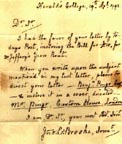Eunice and Ron Shanahan have shared with readers of the Victorian Web this material from their website, Letters from the Past. Click on thumbnails for larger images.

This letter from the past was written more than 200 years ago. I bought it as I collect postmarks of London, and this has a really clear large triple circle datestamp of the type that was in use from 1791 until 1794, when the London Post was re-organised. In the outer circle, it has ' PAID' and the year in two figures, (in this case 92), the month AP with decorative diamonds in the next circle, and the day 19 in a small centre circle. The postage cost of the letter is shown by the manuscript marking in red ink "P/4" . Horsham is 38 miles from London, and the rate in force from 1784 for a distance under 150 miles was 4d. The letter itself is short and to the point:
April 19th 1792
Mr. T C Medwin,
Horsham Sussex
"Herald's College
Dear Sir,
I had the favor of your letter by todays Post, inclosing the Bill for £10 for Mr. Jeffery's years Rent.
When you write upon the subject mention'd in my last letter, please to direct your letter
Benjn Pingo, Esqr - & inclose it in a cover, directed Mr. Pingo, Custom House, London
I am Dr Sir Your most obedt Servt
Jno: C: Brooke, Somt."
£10 for a year's rent? It is frustrating not to know what this was for - but it could well have been for farming land or for property. However the other points of interest arising from the letter just about bring history to life.
Firstly the writer's address 'Herald's College' : otherwise known as the College of Arms, was established by the King in 1484, the thirteen officers of arms are under the control of the Earl Marshal, which office has been inherited since 1660's by the family of the Duke of Norfolk. Six of the officers of arms are heralds named Windsor, Richmond, York, Lancaster, Chester and Somerset. They are members of the sovereign's household.

Click on the image for a larger view
Astonishingly, for such an ancient office, they have a website on the internet, (www.college-of-arms.gov.uk) giving the information that it is the official repository of the coats of arms and pedigrees of English, Welsh, Northern Irish and Commonwealth families and their descendants. Its records also include official copies of the records of Ulster King of Arms the originals of which remain in Dublin. The officers of the College, known as heralds, specialize in genealogical and heraldic work for their respective clients.
The writer of this letter, who signed himself Jno: C. Brooke, Somt. (Jno was a recognised abbreviation at that time for the name John) was a fellow of the Society of Antiquaries, and became Somerset Herald in 1777. He was secretary to the Earl Marshal, and a lieutenant in the militia of the West Riding of Yorkshire.
The man he mentions, Benjamin Pingo (1749-1794), was the fifth son, of Thomas Pingo, an Italian medallist who went to England and who, by 1771, was assistant-engraver at the English Mint. Benjamin was York herald from 1786 — a contemporary of John Brooke, the writer of this letter. There must have been some way he could collect his mail from the Custom House at the time.
I cannot imagine what was "the subject of the last letter" but they would not have had long to ponder about things as John Brooke and Benjamin Pingo were two of the victims of a bizarre accident two years later.
At a performance at the Little Theatre, Haymarket on 3 February 1794 the Royal Command Performance was for three popular pieces; "My Grandmother," "No Song, No Supper," and "The Prize," and the crowd was anxious to get in. Seating in the theatre at that time was of three types — the top of the range seating was the boxes; the galleries, (costing less); and then the Pit, in the centre (which was the preferred place for the real fans) and most popular. The name is still associated with the theatre but now as the 'orchestra pit'.
Anyway, in their anxiety to get into the 'pit' some of the first stumbled and fell, quickly followed by a tumble of bodies. Sixteen people were crushed to death, and many suffered broken limbs. It was decided to keep the news from 'Their Majesties' King George III and Queen Charlotte, who therefore did not know anything about it, until after the performance. When they were informed, they expressed their deepest sorrow and regret, but this did not prevent a pamphlet being produced and circulated castigating them for being unfeeling for watching the performance.
Newspaper reports of the time announced that among those dead were the writer of this letter John Brooke and Benjamin Pingo. As they were members of the Sovereign's household they would definitely have been missed by "Their Majesties". Brooke's body now lies in the church of St Benet, Paul's Wharf.
It is quite surprising how often letters such as this, bought for their postal markings, have interesting contents. Postal history, for me, is becoming more integrated with social history. What is even more surprising is that far from being stuck in the past, I found a lot of information about the contents of this letter from websites and e-mail contacts on the internet. So postal history is definitely not only for the old collector!
Last modified 11 December 2002